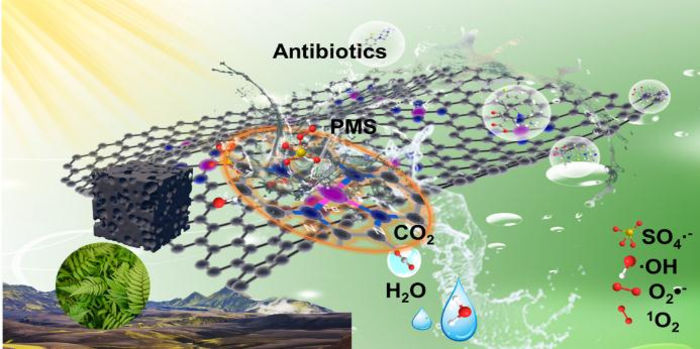Upcycling biomass waste into Fe single atom catalysts for pollutant control
Advertisement
Plants contaminated by heavy metals and antibiotic abuse are two major issues currently facing human sustainable development, as they directly affect food security and drinking water safety. Both pollutants are environmentally persistent and toxic, and can cause potential and long-term negative effects to human health as well as the ecological environment. Rising concerns regarding the addressed issues have all stimulated the search for a more sustainable, eco-friendly solution.

Deconstructing Fe-contaminated biomass waste to obtain FeSAC containing FeN4 active sites as a photocatalyst to remove antibiotics, which embodies the concept of sustainable development and pollutants control.
Journal of Energy Chemistry
Utilizing heavy metal contaminants for catalytic degradation of antibiotics is one particularly promising strategy for processing both contaminants conceptionally. Fe single-atoms confined by a hierarchical porous carbon framework have been fabricated successfully from Fe-contaminated biomass waste ferns for the efficient photocatalytic removal of six typical antibiotics.
Recently, Prof. Kai Yan from Sun Yat-Sen University and Dr. Wenhao Luo from Dalian Institute of Chemical Physics have developed a sustainable methodology to promote the sustainable utilization of biomass waste for the efficient remediation of antibiotic pollution.
This work demonstrates that utilizing Fe-contaminated biomass waste ferns is an appealing and facile strategy for the synthesis of highly active and stable single atom catalysts, and is relevant for pollutant control among other applications.
Original publication
Other news from the department science

Get the chemical industry in your inbox
By submitting this form you agree that LUMITOS AG will send you the newsletter(s) selected above by email. Your data will not be passed on to third parties. Your data will be stored and processed in accordance with our data protection regulations. LUMITOS may contact you by email for the purpose of advertising or market and opinion surveys. You can revoke your consent at any time without giving reasons to LUMITOS AG, Ernst-Augustin-Str. 2, 12489 Berlin, Germany or by e-mail at revoke@lumitos.com with effect for the future. In addition, each email contains a link to unsubscribe from the corresponding newsletter.


























































